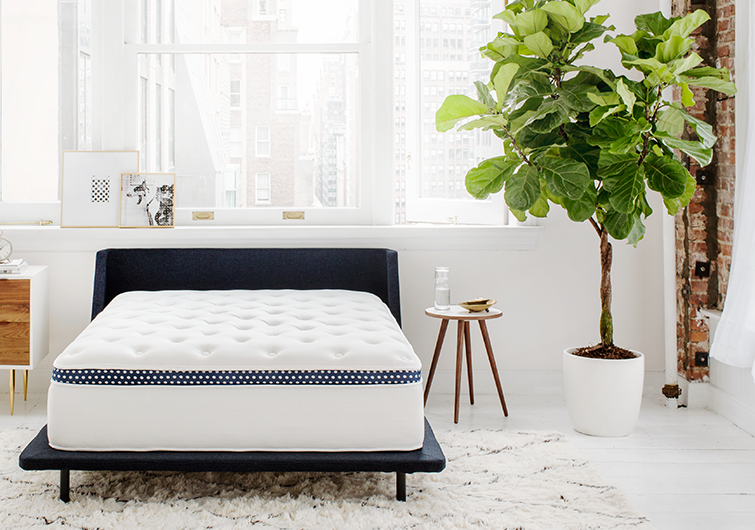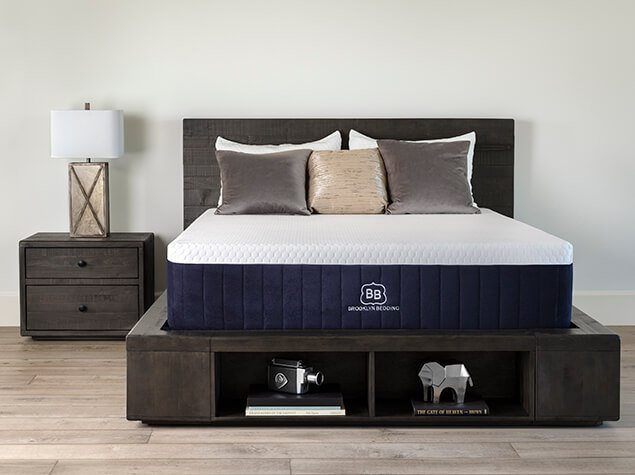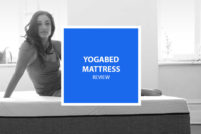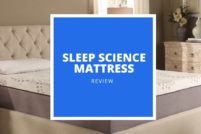The best mattress pick for the widest range of sleepers is the Loom & Leaf Relaxed Firm bed. This mattress is designed to comfortably support all sleep positions and provide a cooler sleep experience.
Mattress firmness refers to how the bed feels when you lie on it. Does it feel plush and soft? Or is it firmer under your back? When you’re buying a new bed, firmness is one of the first features you’ll need to consider. Mattresses are rated on a 10 point scale with 1 being the softest and 10 being the firmest. We’ll go into more detail about each mattress type later on.
Firmness level is a bit subjective and depends on your weight, personal preference, and other factors. So, it’s important to choose the right firmness level for your sleep position and body type. Using the wrong mattress can result in discomfort, pain, and misalignment in your body over time.
In this guide, we’ll give you all the information you need to choose the right firmness level for your next mattress. Let’s check out our top picks for each firmness level, first.
Best Soft Mattress- The WinkBeds Softer Mattress
Why We Liked It:
- Targeted back support
- Plush pillow top
- All-American materials
Why We Didn’t Like It:
- Heavy (hard to move)
The WinkBeds Softer mattress is a three-layer hybrid bed that uses both coils and foam in its construction, for a balanced feel. It is built to be durable and is lab-tested to ensure that the mattress doesn’t sag prematurely.
The “Softer” (4.5 out of 10 softness) model of this mattress has more cushion in the top layer and a more flexible base than the firmer versions of this bed. Soft beds are often suitable for people who don’t weigh much, as their weight can be evenly supported and distributed across the bed.
On the other hand, a firmer mattress may create uncomfortable pressure points for a light person. And a heavier person might experience a soft mattress as too soft due to their extra body weight. Lightweight side sleepers also do well with soft beds as this sleep position requires cushioning for the hips and shoulders.
The cover of the WinkBeds Softer mattress is made with a Tencel™ fabric, a cooling and moisture-wicking material. Under the cover is a plush pillow top to relieve pressure, then a layer of air springs that promote a responsive feel and breathability by helping air move through the bed.
Next is a 2-inch foam layer with a special lumbar region to support your lower back. The mattress has sturdy edges, which makes it easier to get out of bed. Since the coils are individually wrapped, the WinkBeds Softer mattress isolates motion well. It comes with a lifetime warranty and a 120-night sleep trial.
Best Medium-Soft Pick- The Tomorrow Sleep Medium-Soft Mattress
Last update on 2024-04-14 at 13:29 - More InfoProduct prices and availability are accurate as of the date/time indicated and are subject to change. Any price and availability information displayed on Amazon.com at the time of purchase will apply to the purchase of this product." / Affiliate links / Images from Amazon Product Advertising API
Why We Liked It:
- Soft, breathable cover
- Good motion isolation
- 365-day sleep trial
- Gel foam sleeps cool
Why We Didn’t Like It:
- May have an off-gassing odor
The Tomorrow Sleep Medium-Soft mattress is about a 4 out of 10 in terms of firmness, though the brand also offers a 6 out of 10 Medium Firm model. Note that although the Tomorrow Sleep Medium-Soft mattress has a lower firmness number than the WinkBeds Softer model we just reviewed, it doesn’t have the same plush pillow top and so will likely feel slightly firmer. Firmness ratings are somewhat subjective and how firm a bed feels will vary from person to person.
This bed is a good pick for people who want the conforming and motion-isolating benefits of foam with the sturdy durability of coils. The cover of the Tomorrow Sleep Medium-Soft bed has a cool, soft feel that promotes airflow and pulls heat from your body. Next is a 1-inch layer of dense foam material that contours to your body but also regains its shape quickly, unlike softer or slower-responding foam.
Under that is a 2-inch layer of gel foam that provides further conforming with cooling properties. Next is a system of coils that help air move through the bed and give it a bouncy feel. More responsive mattresses like this are easier to switch positions on in the night. The bottom layer is a 1-inch thick base foam that supports the coils.
This mattress is a good pick for couples since it absorbs motion well and is virtually silent when bearing weight. You shouldn’t feel your partner moving around at night.
The Tomorrow Sleep Medium-Soft Mattress comes with a standout, year-long sleep trial and 10-year warranty.
Best Medium Firm Pick- The Loom & Leaf Relaxed Firm Mattress
Why We Liked It:
- Targeted lumbar support
- Isolates motion well
- 15-year warranty
- Easy to move around on
Why We Didn’t Like It:
- Weak edge support
The Loom & Leaf Relaxed Firm mattress is a good pick for people who need some extra back support. It has an enhanced lumbar area that can provide you with relief from pain and tension.
Since it’s medium-firm (6 out of 10), it’s a great pick for sleepers of average weight and should be comfortable in all sleep positions. The bed also comes in a Firm model (8 out of 10).
The Loom & Leaf Relaxed Firm mattress has a comfortable, organic cotton cover. Under the cover is an egg crate-shaped foam layer to promote airflow and provide comfort. The lumbar region is made with proprietary Spinal-Zone gel that eliminates pressure points.
Under that is a contouring memory foam layer for further pressure relief, then a transition layer. Last is a dense 5.5-inch base that helps the mattress maintain its shape.
Since the Loom & Leaf Relaxed Firm bed is an all-foam mattress, it absorbs motion very well, which makes it a good pick for light sleepers who share their bed with a partner.
Note that this mattress isn’t very bouncy or responsive, but it doesn’t create so much sinkage that it’s hard to move around on. It also doesn’t have the most supportive edges, but that shouldn’t be a problem unless you have mobility issues that make it hard to get out of bed in the morning. The mattress comes with a 15-year warranty and a 120-night sleep trial.
Best Firm Mattress- The Brooklyn Aurora Bed
Why We Liked It:
- Sleeps cool
- May help with back pain
- Luxurious, durable design
Why We Didn’t Like It:
- Expensive
- Heavy (hard to move)
The Brooklyn Aurora Firm mattress is a luxurious bed with enhanced lumbar support. Rated as a 7.5 out of 10 firmness level, this bed has effective cooling technology that can help hot sleepers rest more deeply.
It provides some sinkage in the top layer but has a firm feel, overall, which is suitable for back and stomach sleepers. In either of these sleep positions, it’s essential that your hips stay aligned with the rest of your body, which a firmer bed is likelier to deliver than a softer option.
The cover on this mattress is a knit material with a cool feel, followed by a 1.5-inch layer of contouring foam made with antimicrobial copper. Under that is a 2-inch layer of springy latex alternative, which gives the bed a responsive feel and makes it easy to move around without feeling stuck. This bouncy layer makes the bed suitable for combination sleepers who switch positions a lot.
Next is a 2-inch layer of dense foam for compression support. Under that foam layer is a bed of individually wrapped coils which give the bed a supportive bounce, followed by a 1-inch dense base for durability.
The Brooklyn Aurora Firm mattress comes with a 120-night sleep trial and a 10-year warranty to protect your purchase.
Mattress Firmness Levels Explained
Having a lot of options when you’re mattress shopping is great, but it can also be overwhelming (or downright impossible) if you don’t understand how mattress firmness works. Although the 1-10 mattress firmness scale is somewhat subjective, it’s more or less universally agreed-upon by manufacturers. You’ll notice that there’s some overlap in the mattress categories when it comes to specific firmness numbers.
What firmness level is best for your sleep position and weight? How can you know which you’ll prefer? Below, we’ll go over each category to give you a clearer picture of different mattress firmness levels.
Soft Mattresses
Soft beds can range from 2 to 4.5 on the 10-point firmness scale. Although a 1 out of 10 mattress may exist somewhere out there, we’ve never come across one in our reviewing process. Soft mattresses are the least supportive out of all the mattress types. While a low amount of support doesn’t mean zero support, you’ll definitely experience a sinking feeling on a soft mattress, especially if you are heavier.
A soft bed might be suitable for you if you experience uncomfortable pressure points on your body when you sleep on a medium or a medium-firm mattress.
A soft mattress will typically use plush materials, such as a pillow top or foam layers, to create a cloud-like sleep surface. Softer materials tend to wear out faster, so keep that in mind if you choose a soft bed. Let’s look at a couple of factors that will determine how you experience a soft bed.
Sleep Position
The sleep position you favor at night will determine how firm of a bed you should select. Soft mattresses tend to be the best for side sleepers. When you sleep on your side, all your body weight is concentrated in the hips and shoulders. Making sure you get enough cushioning to support these areas of pressure can prevent discomfort in the side sleeping position.
Body Type
Your body type will also determine how firm or soft of a bed you should select. Soft mattresses are typically favored by lighter individuals, rather than average or heavier people. A lighter person is likelier to experience the bed as supportive and cushioning, whereas a heavier person may sink in too deeply into the bed, which will likely be uncomfortable over time.
Medium-Soft Mattresses
Medium-soft beds can range from about a 3 to a 5 out of 10 and are a good pick for people who want plenty of plush pressure relief, but also need more support than they can get from a soft mattress. A medium-soft bed will typically feature foam or latex layers that are just a bit firmer than the layers in a soft bed.
Sleep Position
Like in a soft mattress, a medium-soft bed should feel comfortable for most side sleepers, as it should adequately cushion the hips and shoulders. A medium-soft bed may feel firm in other sleep positions if the sleeper doesn’t weigh very much.
Body Type
As with soft beds, lightweight sleepers usually prefer medium-soft mattresses more than heavier sleepers. If you are over 250 pounds, it’s almost certain that a soft mattress will cause too much sinkage in your hip region and lead to misalignment. Average sleepers may want a medium-soft bed based on their comfort preference. For example, if they just generally like softer mattresses or if have particular health issues that make a softer bed preferable (fibromyalgia, arthritis, etc).
Medium-Firm Mattresses
Medium-firm beds are typically rated between 5 and 7, and provide a supportive, comfortable, and balanced feel for most sleepers. Built to suit the average sleeper, this type of mattress is generally a good choice for most people. A medium-firm bed will create a comfortable sleep surface and should last longer than a softer bed, as denser materials used will help prevent sagging.
In choosing a medium-firm bed, you’ll have access to many different options, as this type of mattress is designed for the average person. This will give you more options when it comes to price and quality, as well. Let’s look at which sleep position and body type is best for this type of mattress.
Sleep Position
You should feel comfortable in all sleep positions on a medium-firm bed. Combination sleepers may experience this mattress type as especially comfortable, as it should adequately support the body no matter which position they use during the night. If you choose a medium-firm bed that creates pressure points in the side sleep position, you can always add a mattress topper to soften it up.
Body Type
Sleepers of average weight should experience a medium-firm bed as the perfect level of firmness. Lightweight sleepers may feel this type of mattress is too firm unless they specifically prefer this feel. Overweight sleepers will typically feel supported by a medium-firm bed. But keep in mind that some will want something even firmer to ensure their body is properly supported for healthy sleep.
Firm Mattresses
Firm beds (typically ranging between 7 and 9, are the most supportive type of mattress available and use the densest materials, meaning they should also last the longest. Just like soft “1 out of 10” beds, we’ve never come across a “10 out of 10” firm mattress. A firm bed will create no sinkage (although some memory foam models might have a small amount). Both the comfort and support layers in this type of bed should make you feel like you’re sleeping on top of the mattress rather than sinking into it.
Firm mattresses may be a good pick for hot sleepers who prefer this feel. When you sink into a mattress, it can create heat retention and cause you to get uncomfortably hot. On a firm bed that keeps you on the mattress surface, however, more of your body is exposed to the air, which helps you stay cooler.
Sleep Position
Firm beds are best for stomach or back sleepers, as they tend to evenly distribute your weight across the bed. Side sleepers may experience a firm mattress as uncomfortable, as it can create tingling or numbness in the shoulder or hip bones in this position.
Body Type
Firmer beds are good for people who are carrying some extra weight. If an overweight person uses a soft bed, the heaviest parts of their body will sink further into the mattress, which can cause misalignment and pain. Firm beds aren’t only suitable for heavy sleepers, though, as some average and even light sleepers will prefer a firmer bed.
Back Pain Considerations
Choosing the right firmness level for your next mattress is essential if you want to prevent back pain or pressure. One of the main causes of sleep-related back pain is a bed that’s too soft for your body type or sleep position.
To prevent back pain, you’ll want to select a mattress that’s firm enough to keep your hips in alignment with the rest of your body, so make sure you are choosing the right level of firmness for your weight and body type. A suitable bed will hold your spine in a neutral position and help you wake up feeling rested.
Using the Right Pillow
While it’s not quite as crucial as the mattress you choose, the right pillow is also important for spinal alignment. Stomach sleepers should use a very low-profile pillow (or no pillow), as too thick of an option will cause their head to point upward at an unnatural angle.
Back sleepers should use a medium-thick pillow to keep their neck in alignment with their spine, as too thin of an option will cause their chin to point toward their chest. This can lead to neck pain over time. Side sleepers need to select a pillow that adequately fills the space between the shoulder and ear to stay properly supported. If you struggle with sleeping hot, select a product with cooling technology, such as a gel pillow.
Final Verdict
Soft and medium-soft beds are best for lightweight side sleepers. Medium-firm mattresses, like the Loom & Leaf Relaxed Firm bed, work well for most body types and sleep positions. Heavier sleepers or those who prefer sleeping on their back or stomach should opt for a firmer pick to ensure proper support. We hope this mattress firmness guide helps you in your quest to find the right mattress for you. Happy mattress shopping!










